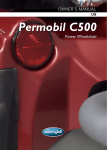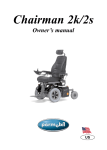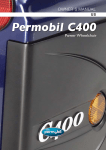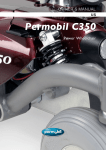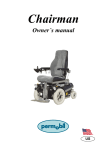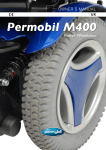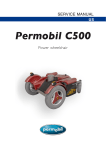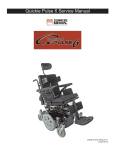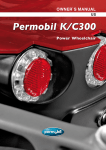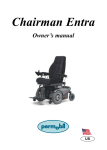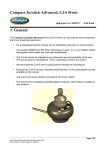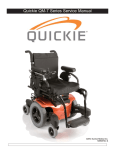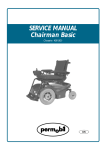Download Street - Permobil
Transcript
OWNER`S MANUAL US Street Power Wheelchair How to contact Permobil Permobil Inc. USA 6961 Eastgate Blvd. Lebanon, TN 37090 USA Phone: 800-736-0925 Fax: 800-231-3256 Email: [email protected] Head Office of the Permobil group Permobil AB Box 120, 861 23 Timrå, Sweden Tel: +46 60 59 59 00. Fax: +46 60 57 52 50 E-mail: [email protected] Street Power Wheelchair Produced and published by Permobil AB, Sweden Edition: 3. 2005-12 Order no. 205200-US-0 Owner’s Manual Street Contents Important Information about the Owner’s Manual ..........................................................6 Safety Instructions........................................................................................................7 Design and function ......................................................................................................12 General - Overview ................................................................................................12 Driving - Shock absorbers .................................................................................... 13 Wheels....................................................................................................................14 Lights, reflectors ....................................................................................................14 Electronics - batteries ............................................................................................15 Main fuse, charging fuse, charging outlet ............................................................15 Seat - electrical seat functions ..............................................................................16 Control panel - overview and functions ................................................................18 Seat Control panel - functions ..............................................................................24 Leverman - functions ............................................................................................25 Handling ........................................................................................................................26 General - Driving....................................................................................................26 Steering ..................................................................................................................27 Driving rules ..........................................................................................................28 Support wheels ......................................................................................................28 Obstacles ..............................................................................................................29 Downhill slopes ......................................................................................................30 Uphill slopes ..........................................................................................................31 Sideways slopes ....................................................................................................32 Releasing the magnetic wheel locks ....................................................................33 Charging the batteries .......................................................................................... 34 Transport ......................................................................................................................36 Transporting by air ................................................................................................37 Maintenance and Repairs ............................................................................................38 Tool Kit....................................................................................................................38 General - batteries, storage ..................................................................................39 Replacing front battery ..........................................................................................40 Replacing rear battery ..........................................................................................41 Cleaning - Wheels..................................................................................................42 Changing inner tube, tires ....................................................................................43 Main fuse................................................................................................................44 Changing, charging fuse ......................................................................................45 Technical Specifications................................................................................................46 Data - Electrical System ........................................................................................47 Troubleshooting Guide..................................................................................................48 Error signals, electronics ......................................................................................50 Accessories ..................................................................................................................52 Important Information about Electromagnetic Interference (EMI) ................................54 Owner’s Manual Street Important Information about this Owner’s Manual Important Information about this Owner’s Manual We congratulate you on your choice of an electric wheelchair. Our goal is for you to continue to feel satisfied with your choice of both vendor and wheelchair. Before you begin using your wheelchair, it is important that you read and understand the content of these operating instructions and in particular the Safety Instructions. These operating instructions are primarily intended to acquaint you with the functions and characteristics of the wheelchair and how you can use them in the best manner possible. They also contain important safety and maintenance information, as well as describing possible problems that can arise while driving the wheelchair. Always keep these operating instructions handy in connection with your wheelchair, since the need for important information can arise concerning its use, safety and maintenance. It is also possible to obtain information concerning our products from our home page on the Internet. You can find us at www.permobil.com. If your wheelchair is marked with the decal "specially adapted product", it has been adapted to your requirements and wishes. This means that its design and functions may differ from the text in the present Owner’s Manual or from the design and functions of other wheelchairs of the same type. All information, pictures, illustrations and specifications are based upon the product information that was available at the time that these operating instructions were printed. Pictures and illustrations that are found in these operating instructions are representative examples and not intended to be exact depictions of the various parts of the wheelchair. We reserve the right to make changes to the product without prior notice. 6 Owner’s Manual Street Safety Instructions Safety Instructions A wheelchair is a motor-driven vehicle, hence extra care must be observed in its use and management. Erroneous use can lead to a risk of injury to the user, to the wheelchair and to their immediate surroundings. In order to minimize any erroneous use of your wheelchair, it is also of the utmost importance that you devote sufficient time to become acquainted with the different buttons, the function and steering controls, the different adjustment possibilities of the seat, etc. of your wheelchair and its accessories before you begin using it. We recommend that you charge your wheelchair's batteries before you begin using it. The chapter titled ”Charging the batteries” describes how to do this. Do not undertake your own first test drive without making sure that you have assistance in the immediate vicinity if you should need help. Carefully select an appropriate place in which to perform your first test drive. The location should be indoors on a level foundation without inconvenient obstacles and the like, and in an environment in which you are familiar. If you do not have the opportunity to perform your first test drive indoors, then you should select a level, dry surface outdoors with a firm foundation and without inconvenient obstacles. If you experience that the wheelchair in any manner is not behaving as expected or if you suspect that something is wrong: abort the test drive as soon as possible, shut off the wheelchair and get in touch with your service contact or Permobil for more information Warning markings The ”warning markings” shown below are used in these operating instructions and are intended to make you aware of conditions that can give rise to unwanted problems, near-accidents, personal injuries or damages to the wheelchair, etc. NOTE Pay attention. WARNING Pay extra attention. Risk of personal injury and of damages to the wheelchair and immediate surroundings. 7 Owner’s Manual Street Safety Instructions NOTE Before beginning to use the wheelchair In order to make sure that nothing happened to the wheelchair while it was being shipped to you, you should check the following items before beginning to use it: NOTE Driving on a loose or soft surface When the wheelchair is set to its lowest speed and the batteries are not fully charged, driving on certain surfaces, for example gravel, sand or thick carpeting, can involve constrained navigability. • that all products ordered are included in the delivery, incl. operating instructions and possible other documentation. If you suspect that something is missing, then contact your supplier or Permobil for more information as soon as possible. Driving in darkness Driving in the dark may only be done if your wheelchair is equipped with functioning lighting in the front and the back, or as per the applicable national or local traffic regulations. • that no transport-related or other damages have occurred to the wheelchair and its accessories. If you discover that something has been damaged or in some other manner appears to be incorrect, then contact your supplier or Permobil for more information as soon as possible before you continue the checks. Driving in extreme climate conditions Permobil's wheelchairs are designed to withstand most adverse weather conditions, however to minimize the risk of being caught in difficult situations you should avoid using the wheelchair outdoors during, for example, severe cold, heavy rain or thick snow. Test drive Carefully select an appropriate place in which to perform your first test drive. The location should be indoors on a level foundation without inconvenient obstacles and the like, and in an environment that you are familiar with. If you do not have the opportunity to perform your first test drive indoors, then you should select a level, dry surface outdoors with a firm foundation and without inconvenient obstacles. Also bear in mind that certain surfaces on the wheelchair can be heated up or cooled down in the event of prolonged exposure to intense sunlight or cold respectively. If you experience that the wheelchair in any manner is not behaving as expected or if you suspect that something is wrong: Abort the test drive as soon as possible, shut off the wheelchair and contact your service contact or Permobil for more information. Max. weight user See Owner’s Manual for respective seats. 8 Owner’s Manual Street Safety Instructions NOTE Maintenance and service Perform only the service and maintenance that are specified in the operating instructions as being appropriate to be performed by the user. All other service and maintenance must be performed by a person with sufficient expertise to be able to perform such in a professional manner. NOTE Storage The wheelchair and its accessories must always be shut off when they are not being used. Always store the wheelchair so that access for unauthorized individuals is avoided. Never store the wheelchair in a room in which condensation can arise (mist or dampness on the surfaces) e.g. in pool areas, laundry rooms, or similar rooms. Charging of batteries Charging must be done in a well-ventilated room, not in a wardrobe or closet. Charging must not be done in a bathroom or wet room. Only chargers with a max 10 A charging current (average value) may be used. When the charger is connected, the chair must not and cannot be driven. If you are unsure as to how your wheelchair and its accessories should be properly stored, contact your supplier or Permobil for more information. EMC requirements The electronics of an electrical wheelchair can be affected by external electromagnetic fields (for example from mobile telephones). Similarly, the electronics of the wheelchair itself can also emit electromagnetic fields that can affect the immediate surroundings (for example certain alarm systems in businesses). Recycling of batteries Used or broken drive batteries should be taken care of in an environmentally correct manner in accordance with locally applicable recycling directions. Changing tires Avoid the use of sharp-edged tools when working with tires. Ordering of documentation Service Manual can be ordered from Permobil, ask for item No. 205201-UK-0. The limit values for Electromagnetic Compatibility (EMC) with respect to electrical wheelchairs is set in the harmonized standards for the EU in the Medical Devices Directive, No. 93/42/EEC. Spare Spart Catalog can be ordered from Permobil, ask for item No. 205202-UK-0. Permobil's electronic wheelchairs comply with these limit values. If you are in need of another copy of the Owner’s Manual, it can be ordered from Permobil, ask for item No. 205200-US-0. Also see Important Information about Electromagnetic Interference (EMI) on page 54-55. 9 Owner’s Manual Street Safety Instructions WARNING Transfer into and out of the chair The wheelchair must always by shut off and the wheel locks engaged during transfer into and out of the chair. Avoid stressing the seat's armrest with your entire body weight while transferring into and out of the chair. WARNING Driving on sideways slopes The wheelchair must not be driven on sideways slopes greater than 6 degrees. With larger slopes the risk of tipping over increases and the maneuverability and stability of the wheelchair can deteriorate rapidly. Always drive at the lowest possible speed and avoid substantial evasive maneuvering. Support wheels The rear support wheels must always be mounted when the wheelchair is being driven. Negotiating obstacles Do not drive the wheelchair over edges taller than 2.5 in. Driving over tall edges increases the risk of tipping over as well as the risk of damage to the wheelchair. Negotiating obstacles must always be done with great care. Driving with seat lift/seat tilt Be careful in making sure that nothing gets stuck between the chassis and the seat when the seat lift/seat tilt is operated. An elevated seat lift raises the center of gravity and increases the risk of tipping over, so use the seat lift / seat tilt only on level ground. Driving on uneven, wet and icy surface Observe particularly great care when you are driving in hilly terrain when the surface consists of gravel, wet grass, ice, snow, clay, etc. On such foundations, the wheelchair's braking distance and maneuverability can deteriorate rapidly. Fixed seat post Adjusting the seat height may only be performed by an authorized service provider. See the service manual for more information. Releasing the wheel locks In order to avoid having the wheelchair roll away, make sure that the wheelchair is on a flat foundation before the wheel locks are released. The wheel locks must not be released during transport on inclines. Driving on separate ramps and the like Always check before driving on separate ramps and the like that both of the wheelchair's front and rear wheels can pass over the ramps in a safe manner. Driving near precipices Always be sure keep a safe distance from precipices when the wheelchair is driven on ramps, bridges, heights and similar places. Be aware that the chair will not have brakes when wheel locks are in the free-wheel position. Driving on steep slopes The wheelchair must not be driven on rising or declining slopes of more than 10 degrees*). When these limits are exceeded, the risk of tipping over increases and the maneuverability and stability of the wheelchair can deteriorate rapidly. Always drive at the lowest possible speed and avoid substantial evasive maneuvering. *) Dynamic stablity according to ISO 7176-2= 6°. Driving the leg rest with separate foot plates With the wheelchair kept still and having the leg rest driven towards it’s innermost position, the wheelchair’s front wheels must always be kept in a 90 degrees straight position pointed forward or backwards. With the front wheels pointed sideways, there is a risk that the leg rest with foot plates might be damage if they are hit against the front wheels. There is also a risk for the user to get caught between the foot plates and wheels. 10 Owner’s Manual Street Safety Instructions WARNING Maintenance and service All installation, adjustment and other invasive work on the wheelchair and its accessories must only be performed by persons who are quite familiar with the handling and functionality of the product. WARNING Damages/malfunctions on the wheelchair and its accessories If you experience that the wheelchair in any manner is not behaving as expected or if you suspect that something is wrong: Stop driving as soon as possible, shut off the wheelchair and contact your service contact or Permobil for more information. All alterations and invasive work to the wheelchair and the vital systems of its accessories must be performed by an authorized service provider. Always contact an authorized service provider or Permobil if you are in doubt. It’s also of greatest importance that Permobil be informed if the wheelchair and its accessories have been subjected to transport damages, damages during driving or damages due to another cause as soon as possible after the event. There exists a risk that the wheelchair and its accessories can no longer be used in a safe and secure manner. Please note that the wheelchair is heavy and contains many moving parts, which means that the risk of being caught between them is always present. Hence great care should be observed during all work with the wheelchair and its accessories. Protective equipment (protective clothing, gloves, glasses) must always be used when such are specified in the operating instructions. Transport The wheelchair must be transported in or with transport solutions that have been approved for this purpose. Check that the wheelchair is properly secured and that the wheel locks are not disengaged. The wheelchair can be locked into position by running fastening straps through the brackets at the front and back. Also check that the fastening points on the transport vehicle are well-anchored. Changing batteries and fuses The main fuse must always be shut off when batteries and fuses are replaced. Observe care in the use of metallic objects when working with batteries. A short-circuit can easily cause an explosion. Always use protective gloves and protective eye-glasses. A defectively fastened chair can cause extensive damage and injury both to the people in the transport vehicle as well as to the vehicle itself and the wheelchair if it comes loose. Filling air into tires Check at regular intervals that the wheelchair's tires have the prescribed tire pressure. Incorrect tire pressure can cause deteriorating stability and maneuverability. Passengers The wheelchair is not intended to transport passengers, regardless of the age of the passenger. The Maximum User Weight stated in the Owner's Manual for your seating includes the user and any personal effects. The Maximum limit should not be exceeded. The wheelchair's maneuverability and stability can be degraded as a result. The prescribed tire pressure is 36 psi (250 kPa). Note that overfilling causes a risk of explosion. 11 Owner’s Manual Street Design and Function Design and function General The Street is an electrical rear wheel drive wheelchair for outdoor and indoor driving intended for persons with functional impairments. The wheelchair consists of a chassis and a seat. The chassis contains the wheelchair's electronics, power supply and drive functions. The seat consists of the seat frame, seat plate/back rest, arm rest/leg rest, seat lift and possible accessories and additional options such as a head support, calf rest, chest support, etc. The Street can be combined with different seat models, which are supplied with separate operating instructions. In these operating instructions, we have chosen to show the wheelchair with our Corpus IIST seat. The management of the chassis and most of its functions are, however, the same regardless of which seat model is selected. Overview 1 2 3 10 4 9 5 8 6 7 1. 2. 3. 4. 5. Head Support (accessories) Back Rest Control Panel Seat Leg Support 12 6. 7. 8. 9. 10. Foot Plate Front Wheel Rear Wheel (drive wheel) Chassis Arm Rest Owner’s Manual Street Design and Function Driving The Street has rear wheel drive and is equipped with a drive package for each drive wheel. The drive package consists of an electric motor with a drive gear and magnetic wheel lock. Wheel lock Electric motor Drive gear Shock absorber The wheelchair is equipped with four shock absorbers with an adjustable spring force. If no specific user weight is given when the wheelchair is delivered, the shock absorbers will be set to a default value corresponding to a user weight of 110 - 155 lbs. Adjustment of the spring force Adjustment ought to be performed by personnel who are well-acquainted with the design and functionality of the shock absorbers. When adjustment is needed, contact your nearest service provider or service center, or Permobil service. Rear shock absorbers Front shock absorbers 13 Owner’s Manual Street Design and Function Wheels The wheelchair's rear wheels, the drive wheels, have air-filled tires. The front wheels, the guide wheels, can either be air-filled or solid rubber tires. The guide wheels are available in two sizes. Lights and reflectors In the standard version the wheelchair is equipped with reflectors in the front and back as well as on the sides. Front/back lights and turn indicators are optional. Front reflectors Rear reflectors Side reflectors 14 Owner’s Manual Street Design and Function Electronics The wheelchair's batteries are located under the front and rear covers of chassis respectively. Both of the batteries are easily accessible for maintenance and battery replacement. Front battery Rear battery Main fuse/Charging fuse/Charging outlet The main fuse is located in an outlet in the front of the rear chassis cover. The charging fuse is located on the front edge of the front chassis cover, under the the wheel lock release lever. The charging outlet is located on the left side of the front chassis cover. Main fuse Charging fuse 15 Charging outlet Owner’s Manual Street Design and Function Seat See the supplied Owner’s Manual for the seat. Manual seat functions See the supplied Owner’s Manual for the seat. Electrical seat functions The wheelchair's electrical seat functions are operated via the wheelchair's control panel or a seat control panel in connection with the control panel. Power Adjustable Seat Height The Street can be equipped with an seat elevator, making it possible to raise the seat up to 9.75 in. in order to conveniently be able to adjust the height for tables, workbenches, etc. If the seat lift is raised more than 1.125 in. from its lowest position, the wheelchair can only be driven with a reduced maximum speed, and the seat tilt cannot be activated. If the seat lift is raised more than 2.5 in. above its lowest position, the back rest tilt will not activate backwards. NOTE The seat lift will not raise the seat if the seat tilt is activated at more than 10° or if the back rest tilt is activated by more than 10° backwards. Seat tilt The Street can be equipped with an electrically controlled seat tilt that makes it possible to set the seat angle to up to 45°. When driving with the seat tilt activated at up to 20°, the wheelchair will drive at its maximum speed. With the seat tilt activated at over 20° but not more than 30° the maximum speed is reduced. NOTE If the seat tilt is activated at more than 30°, the chair will not drive. If the seat tilt is activated to more than 30° while driving, the chair will stop. In order for driving to be able to be resumed, the seat tilt must be run back to less than 30°. When driving with the seat tilt activated at more than 10°, the seat lift will not raise the seat. The seat tilt will not activate if the seat lift is run higher than 1.125 in. 16 Owner’s Manual Street Design and Function Electric back rest The Street can be furnished with an electrically controlled back. With the back tilt activated at more than 15° backwards, the wheelchair will only drive at a reduced maximum speed. NOTE If the back tilt is activated at more than 10° backwards, the seat lift will not raise the seat. Electric leg support The Street can be furnished with an electrically controlled leg support. NOTE NOTE! The following applies only if your wheelchair is equipped with separate foot plates. If the leg supports have been driven towards it’s innermost position, the wheelchair can only be driven at reduced speed. To allow it to be driven at full speed, the leg supports must be moved out to a position at which there is no risk of the foot plates coming into contact with the front wheels. If the leg supports are moved in too close to the front wheels while the wheelchair is moving, the wheelchair’s speed will be reduced. To resume driving at full speed, the leg supports must be moved out again. WARNING NOTE! The following applies only if your wheelchair is equipped with separate foot plates. With the wheelchair kept still and having the leg supports driven towards it’s innermost position, the wheelchair’s front wheels must always be kept in a 90 degrees straight position, (A), pointed forward or backwards. With the front wheels pointed sideways, (B), there is a risk that the leg rest with foot plates might be damage if they are hit against the front wheels. There is also a risk for the user to get caught between the foot plates and wheels. A. Correct angle front wheels B. Incorrect angle front wheels 17 Owner’s Manual Street Design and Function Control panel The control panel consists of a joystick, function buttons and indicator symbols. Your wheelchair may also be equipped with an extra seat control panel in addition to the control panel. You can choose whether you wish to control the electrical seat functions from the seat control panel or from the control panel. Control panel overview Function buttons/Indicator lights Joystick Seat control panel 18 Owner’s Manual Street Design and Function Function buttons/Indicator symbols On the control panel there are a total of 7 function buttons and a total of 3 indicator symbols. Function buttons Power Switch, on/off Warning Light Lighting (option) Left Turn Indicator Right Turn Indicator ”MODE” Selector Signal Indicator symbols Battery Voltage Indicator Speed Indicator 19 Seat Indicator Owner’s Manual Street Design and Function Panel display for control panel JSM-L 7key Pilot+ NOTE! If your wheelchair is not equipped with lights (option) the push buttons for lights and turning indicators have no function. However the turning indicator lamps on the control panel flash when the warning button is activated. Overview Power Switch, on/off Warning Symbol Button to power up and power down the weehlchair. The Power Switch must have been pressed for the chair to operate. When you press the switch, the indicator lamps for warning symbol (red lamp) and for both indicator lights (green lamp) flash on the control panel. If your wheelchair is equipped with lights, the turning indicators on the chassis also flash to attract attention. NOTE! This function works even when the start button is switched off. Turning Indicators MODE (selector) Pressing the right or left arrow activates the wheelchair’s turning indicators. Activates the speed indicator and electric seat functions. 20 Owner’s Manual Street Design and Function Lights (option) Warning Horn Press the switch to turn on the lights of the wheelchair. Press the button to sound the horn and attract attention. Battery Voltage Indicator Speed Indicator The window display on the control panel shows the following indicator lights (from bottom to top): Indicates the adjusted speed at which the wheelchair is set. 1 - 2 lamps 3 - 4 lamps 5 lamps Red+Yellow+Green = Fully charged Red+Yellow = Half charged Red = Charge the batteries = Low speed = Medium speed = Maximum speed Seat Function Indicator Indicates active seat function when Leverman is used. 21 Owner’s Manual Street Design and Function Security key The security key can be used to lock the wheelchair to prevent unauthorized use. To lock the wheelchair it must be switched on, the key should then be inserted into and withdrawn from the panel outlet, the wheelchair will now be locked. To unlock the wheelchair, switch it on. The maximum speed indicator will ripple up and down but driving will not be possible. The key should now be inserted into and withdrawn from the panel outlet, the wheelchair can now be driven. Panel outlet with security key 22 Owner’s Manual Street Design and Function Joystick The joystick is used to regulate the speed of the wheelchair forwards or backwards, to turn and to brake. The speed is regulated proportionally by moving the joystick forwards or backwards and the speed is directly proportional to the movement of the joystick (small movement low speed - large movement high speed). The wheelchair is turned by moving the joystick to the left or right. The wheelchair is braked by moving the joystick back to the neutral position or letting it go. Joystick 23 Owner’s Manual Street Design and Function Seat control panel With this panel, the wheelchair’s electrical seat functions are controlled. NOTE! The number of available functions and their position on the panel, can vary depending on how your wheelchair is equipped. 1 2 3 1. Seat Lift The seat is raised when the top part of the seat lift button is pressed, and lowered when the bottom part of the button is pressed. 4 3. Seat Tilt The seat moves forwards when the top part of the seat tilt angle button is pressed, and is angled backwards when the bottom part of the button is pressed. 2. Back Rest tilt The backrest is tilted forwards when the top part of the backrest angle button is pressed and backwards when the bottom part of the button is pressed. 4. Leg Support The leg support moves forwards when the top part of the leg support button is pressed, and backwards when the bottom part of the button is pressed. 24 Owner’s Manual Street Design and Function Leverman (Joystick manager) With the help of Leverman, you can set the maximum speed of the wheelchair and also control the electic seat functions. Speed selector Press MODE button once. The speed indicator lights flash and by moving the joystick to the right/left you can increase/decrease the maximum speed of the wheelchair. - Confirm your setting and return to drive by pressing the MODE button twice or move on to next step by one press. NOTE! If the joystick is moved forwards/backwards during setting of the maximum speed, the chair will go back to drive mode using the present speed range. Leg support Press MODE button twice. The right foot plate indicator lamp is lit. Move the joystick forward/backwards to move the leg support out or in. - Make your adjustment and return to drive by pressing the MODE button once or go on to next step by moving the joystick to the right. Seat lift/Seat tilt/Back rest Press MODE button twice. The right foot plate indicator lamp is lit. By moving the joystick to the right or left you can now select desired seat function and make your adjustments by moving the joystick forward/backwards. - Return to drive by pressing the MODE button once. MODE button Speed Indicator Leg Support activated Seat Lift activated SeatTilt activated Back Rest Tilt activated 25 Owner’s Manual Street Handling Handling General The Street is designed for indoor and outdoor use. When driving indoors, you must observe care when driving in, for example, narrow passageways, when passing through doors and entries as well as when using elevators, ramps, etc. Also be conscious of the risk of things getting caught in the machinery when you use the electrical seat lift and seat tilt, in particular when the wheelchair has been run in under a table, workbench or the like. Outdoors, you must remember to drive very slowly on steep downhill slopes and to observe great care when driving on uneven foundations, on uphill slopes, with sideways slopes and when negotiating obstacles. Always maintain a safe distance from the edge when driving close to drop-offs and precipices. We recommend that you make repeated test drives in surroundings in which you know you feel secure so that you are quite familiar with how the wheelchair and its accessories behave in different situations before you begin using the wheelchair on normal roads and other public areas. Driving 1. Switch on the power by pressing the Power Switch button on the control panel. 2. Set an appropriate maximum speed by first pressing the “MODE” button and then selecting the speed with the joystick until the desired indicator lamp lights up for your type of driving. It is preferable to begin with a low speed. Then press the ”MODE” button twice or activate the joystick forward in order to return to driving. 3. Carefully move the joystick forward to drive forwards, and backward to drive backwards. 4. The speed of the wheelchair is adjusted continuously by the joystick being moved different distances forward and backward respectively. The wheelchair's electronics make creep driving possible over edges (max. 2.5 in.). You can drive up to the edge, and then carefully drive over it. Power Switch button Speed Indicator Low High 26 MODE button Selector Owner’s Manual Street Handling Steering By moving the joystick to one or the other side while driving forwards or backwards, the wheelchair will turn in the desired direction. Always think about driving as flexibly as possible and avoid severe braking and avoidance maneuvers. Driving forwards/backwards Steering/turning NOTE Do not perform the first test drive on your own. The test drive is of course just a check of how you and the wheelchair function together, and you may need some assistance. NOTE Before driving, check that the wheel lock release lever is set in the drive position. 27 Owner’s Manual Street Handling Driving rules Support wheels The support wheels mounted at the rear minimize the risk of the wheelchair tipping over backwards when passing obstacles and the like, and they must always be mounted when the chair is being driven. Rear support wheels WARNING The rear support wheels must always be mounted when the chair is being driven. There is a risk of tipping. 28 Owner’s Manual Street Handling Driving over obstacles Do not drive the wheelchair over obstacles of a height greater than 2.5 in. Driving over tall edges increases the risk of tipping over as well as the risk of damage to the wheelchair. Negotiating obstacles must always be done with great care. Max 2.5 in. WARNING Do not drive the wheelchair over obstacles of a height greater than 2.5 in. Negotiating obstacles must always be done with great care. WARNING An elevated seat lift raises the center of gravity and increases the risk of tipping over, hence the seat lift and seat tilt should only be used on level ground. 29 Owner’s Manual Street Handling Driving on downhill slopes Driving on downhill slopes must always be done at a low speed and with great care. Avoid rapid braking, abrupt avoidance maneuvers and never maintain a speed higher than that at which you can maneuver the wheelchair in a safe and secure manner. When driving on downhill slopes with an uneven surface (for example grass, gravel, sand, ice or snow) a great deal of extra care must be observed. Max 10°*) WARNING Do not drive down a downhill slopes with a slope of greater than 10 degrees. *) Dynamic stability according to ISO 7176-2= 6°. WARNING An elevated seat lift raises the center of gravity and increases the risk of tipping over, hence the seat lift should only be used on level ground. 30 Owner’s Manual Street Handling Driving on uphill slopes Driving on uphill slopes must always be performed with great care. Avoid abrupt avoidance maneuvers and never maintain a speed higher than that at which you can maneuver the wheelchair in a safe and secure manner. When driving on uphill slopes with an uneven surface (for example grass, gravel, sand, ice or snow) a great deal of extra care must be observed. Max 10°*) WARNING Do not drive up an uphill slope of greater than 10 degrees. *) Dynamic stablility according to ISO 7176-2= 6°. WARNING An elevated seat lift raises the center of gravity and increases the risk of tipping over, hence the seat lift and seat tilt should only be used on level ground. 31 Owner’s Manual Street Handling Driving with sideways slopes Driving with a sideways slope must always be performed with great care. Avoid abrupt avoidance maneuvers and never maintain a speed higher than that at which you can maneuver the wheelchair in a safe and secure manner. When driving on sideways slopes with an uneven surface (for example grass, gravel, sand, ice or snow) a great deal of extra care must be observed. Max 6° WARNING Do not drive the wheelchair on sideways slopes of greater than 6 degrees. There is a risk of tipping over. WARNING An elevated seat lift raises the center of gravity and increases the risk of tipping over, hence the seat lift should only be used on level ground. 32 Owner’s Manual Street Handling Releasing the manual wheel locks The wheel locks can be released in order to make it possible to move the wheelchair manually. 1. Shut off the wheelchair using the Power Switch button on the control panel. 2. Move the wheel lock release lever to the right, see the picture. The chair can now be moved manually. Location of the wheel lock release Releasing the wheel locks WARNING Do not engage or disengage wheel locks unless power to the chair is off. In order to avoid the wheelchair rolling away, ensure that the wheelchair is on a level and dry base before releasing the wheel locks. Be aware that the chair will not have brakes when wheel locks are in the free-wheel position. Make sure that the person pushing the chair has full control when wheel locks are disengaged. Always reset the wheel lock release after manually moving the wheelchair. NOTE When the wheel locks are released, the chair will not drive. 33 Owner’s Manual Street Handling Charging the batteries When should the batteries be charged? For optimum use of the batteries with respect to driving time per charging and total lifespan, the batteries must be charged regularly. Always shut off the wheelchair when it is not being used to avoid draining the batteries completely. Make it a habit to charge the batteries when you are not using the wheelchair. The battery voltage indicator on the wheelchair's control panel shows when the batteries are low. NOTE The main fuse must always be in the ”ON” position when charging is being performed. NOTE If the batteries should be drained completely, it is important that you charge them up again as soon as possible since a complete loss of charge reduces the lifespan of the batteries. WARNING Observe care in the use of metallic objects when working with batteries. A short-circuit can easily cause an explosion. Always use safety gloves and protective eye-glasses. Only chargers with a max 10 A charging current (average value) may be used. (The RMS value of the charging current must not exceed 12A.) Charging must be done in a well-ventilated room, not in a wardrobe or closet. Charging must not be done in a bathroom or wet room. The charger's charging cable must not be extended. The charger can become hot and hence must not have anything covering it. The charger must be positioned so that there is an air gap on all of its sides. The charger contact must be replaced if it is damaged or becomes hot during charging. Both the contact on the charger's cord and the wheelchair's charging input should be replaced if one of them is damaged or worn. Replacement of contacts must be performed by qualified personnel. 34 Owner’s Manual Street Handling Charging 1. Connect the charger cable from the charger to the charging socket on the wheelchair. 2. Connect the charger to the 110 volt supply and turn on the power for the charger. Description and Use of Battery Charger, see supplied Owner’s Manual. WARNING To avoid sparking and unnecessary wear and tear of the wheelchair’s charging socket, be sure that the main voltage and the charger is in OFF position when connecting/disconnecting the charging cable to the wheelchar’s charging socket. Charging socket location Charging socket 35 Owner’s Manual Street Transport Transport The wheelchair must only be transported in a vehicle that is approved for such purposes. Check that the wheelchair is properly fastened and that the wheel locks are engaged. The wheelchair can be locked into position by running fastening straps through the brackets in the front and the back. Also check that the fastening points on the transport vehicle are well-anchored. WARNING A poorly fastened chair can cause extensive damage and injury both to the people in the transport vehicle as well as to the vehicle itself and the wheelchair if it comes loose. Front fastening brackets Rear fastening brackets 36 Owner’s Manual Street Transport General advice for Air transport When transporting your wheelchair by air, there are especially these three items you should consider: 1. Batteries Gel batteries: In most cases they don’t need to be taken out of the wheelchair. Just be sure of that the wheelchair’s main fuse is in OFF position. Acid batteries: Most airlines require that the batteries should be taken out of the wheelchair and that they must be transported in special boxes that the airline can provide. 2. Dimensions and weight of the wheelchair How much the wheelchair weighs, and how large it is, is of significance depending upon the type of aircraft by which the wheelchair is to be transported. The smaller the aircraft, the smaller the wheelchair can be/weigh and vice versa. Always check with the airline concerned for the rules that will apply. 3. Preventing damages During air transport, the wheelchair will be together with other goods in a cramped room, hence it is important that preventive measures be performed in order to minimize transport damages to the wheelchair. Cover up the control panel with a soft, shock-absorbing material (plastic foam or the like) and fold it in towards the backrest. Protect other protruding objects in the same manner. Tape any possible loosely hanging cabling firmly to the seat or the cover. NOTE Certain airlines can refuse to take acid batteries onboard. NOTE In order to ensure that the transport can take place in a safe manner and that no unpleasant surprises arise at the last minute, you should always contact the respective airlines before the transport. 37 Owner’s Manual Street Maintenance and Repairs Maintenance and Repairs In order for your wheelchair to function well it is important that it is used in the correct manner and that regular maintenance is performed. A well-maintained wheelchair will have a longer lifespan and minimizes the risk that defects will arise. Tool Kit A tool kit comes with the wheelchair and contains the following that can be used for performing maintenance and easier repairs. TOOL AREA OF USE Protective eye-glasses Work on the batteries Set of Allen keys General maintenance/adjustment of seat 1 x 10-11 mm spanner General maintenance/battery replacement 1 x 12-13 mm spanner General maintenance/battery replacement Screwdriver General maintenance/battery replacement Safety key Lock/unlock the wheelchair NOTE Certain repairs can require tools other than those that come with the wheelchair. NOTE The main fuse must always be shut off when replacing batteries or fuses. Always shut off the power supply to the control panel before switching off the power with the main fuse. WARNING All inappropriate modifications to the wheelchair and its different systems can cause an increased risk of accidents. All changes and intrusive work on the wheelchair's vital systems must be performed by an authorized serviceman. Always contact an authorized serviceman or Permobil when in doubt. 38 Owner’s Manual Street Maintenance and Repairs General batteries/Storage • Note that a battery drains on its own and a discharged battery can freeze and burst when it is cold. If the wheelchair must be stored without being used for a longer period of time, the batteries should always be charged up once per month so that they do not incur any damage. • The wheelchair must not be stored in a room where condensation arises (mist or dampness on the surfaces) e.g. laundry rooms or similar rooms. • The wheelchair can be stored in an unheated room. What is best for the wheelchair from a corrosion standpoint is that the room be some degrees warmer than its surroundings, which keeps the room drier. • If the wheelchair is equipped with acid batteries, the acid level should be checked regularly. If the wheelchair is equipped with GEL batteries, the fluid level need not be checked. • The lifespan of the batteries depends entirely upon regular charging. Short-term storage In order for the charging procedure to give a battery with good capacity, the temperature in the storage room must not be lower than 41 F. Storage at under 41 F increases the risk of the battery not being fully charged when it is to be used as well as increasing the risk of corrosion. Long-term storage Storage can occur in an unheated room, however the battery should be maintenance-charged at least once per month. WARNING Observe care in the use of metallic objects when working with batteries. A short-circuit can easily cause an explosion. Always use safety gloves and protective eye-glasses. 39 Owner’s Manual Street Maintenance and Repairs Changing the batteries Front battery 1. Place the wheelchair on a level surface. 2. Run/fold out the leg support and, if possible, raise the seat lift. 3. Shut off the main fuse. 4. Loosen the front chassis cover from both guide pins by pressing the covers both sides inwards and then lifting the cover upwards/ forwards. Press both sides of the cover inwards 5. Loosen the battery terminals. Also see the sticker on the inside of the chassis cover. 6. Use a blunt screwdriver or the like to lift up the lower edge of the battery via the hole under the front edge of the battery cover (see picture). 7. Lift the battery out using the battery strap. 8. Insert the new battery using the battery strap. Let the strap remain on the battery. Lift the cover upwards/forwards 9. Connect the battery terminals. 10. Remount the chassis cover. 11. Switch on the main fuse. Lift the battery’s lower edge before taking it out 40 Owner’s Manual Street Maintenance and Repairs Rear battery 1. Place the wheelchair on a level surface. 2. If possible, raise the seat lift. 3. Shut off the main fuse. 4. Loosen the chassis casing's rear part from the guide pins and lift it up a bit. 5. Open the battery hatch with the knob and lower the hatch to the rear. 6. Pull out the battery using the battery strap so that the battery connections become accessible. Loosen the rear edge of chassis cover 7. Loosen the battery terminals. Also see the sticker on the inside of the battery hatch. 8. Lift the battery completely out. 9. Insert the new battery in using the battery strap. Let the strap remain on the battery. 10. Connect the battery terminals. Open the battery hatch with the knob 11. Lock the battery hatch. 12. Remount the chassis cover. 13. Switch on the main fuse. Pull out the battery with the strap 41 Owner’s Manual Street Maintenance and Repairs Cleaning Clean the wheelchair often. It is particularly important that the chair be cleaned after being used outdoors. Use a damp cloth with a mild soap solution in order to wipe off dirt and dust. Cleaning of seat surfaces See recommended washing instructions in the separate operating instructions for respective seats. WARNING Do not rinse the wheelchair off with a water hose, its electronics can be damaged. The wheelchair must always be shut off while it is being cleaned. Wheels Check at regular intervals that the wheelchair's tires have the prescribed tire pressure. An incorrect tire pressure can cause deterioration in stability and manueverability, plus extremely low air pressure can give rise to abnormal wear as well as shorter driving distances. So check regularly to see that the tires are maintained at a pressure of 36 psi (250 kPa). Filling with air 1. Unscrew the plastic caps on the air valves of the front and rear tires respectively. 2. Connect the compressed air nozzle to the air valve and adjust the tire pressure to the prescribed level. Filling valve, rear tire Socket head cap screws and filling valve, front tire 42 Owner’s Manual Street Maintenance and Repairs Replacement of rear tire inner tube 1. Put the wheelchair up on blocks so that the wheel is free and then let the air out of it. 2. Force the tire off the rim. 3. Replace the broken inner tube. 4. Put the tire back on the rim and fill with air. Replacement of front tire inner tube NOTE Applies only if your wheelchair is equipped with air-filled front tires. 1. Put the wheelchair up on blocks so that the wheel is free and then let the air out of it. 2. Part out the rim by unscrewing the five socket head cap screws that are holding the rim together. 3. Replace the broken inner tube. 4. Assemble the rim back together again with the tire, check that the innertube is not caught anywhere between the parts of the rim, and fill with air. WARNING The recommended air pressure for front/rear tires is 36 psi (250 kPa). Overfilling causes a risk of explosion. Incorrect tire pressure can involve a deterioration of stability and manueverability, so check regularly that the tire contains the prescribed air pressure. Wheel Lock Release Check regularly, approx. once per month, the functionality of the wheel lock release. The wheelchair must not be possible to drive when the wheel locks are disengaged. Location of the wheel lock release Wheel lock release lever 43 Owner’s Manual Street Maintenance and Repairs Resetting of main fuse/battery cut-out The main fuse also functions as a battery cut-out, but in the operating instructions it is generallly called the main fuse. Replacement of the main fuse is normally not necessary as it is of the automatic type that can be reset when it has been thrown. The resetting is done by placing the switch in the "ON" position. NOTE Always shut off the power supply on the control panel before switching off the power with the main fuse. The main fuse is accessible via an outlet in the chassis cover, see picture below. 1. Check the decal to see what the ON and OFF positions are. Fold up the rubber protector and flip the switch towards the direction indicated by the sticker. 2. Fold the rubber protector back. Location of the main fuse Main fuse in “ON” position WARNING A thrown main fuse often involves larger electrical faults. The cause should be checked carefully before the switch is reset. Always contact an authorized serviceman or Permobil when in doubt. 44 Owner’s Manual Street Maintenance and Repairs Replacement of charging fuse The fuse holder for the charging fuse is located under the wheel lock release lever on the front edge of the front chassis cover. Charging fuse location Charging fuse 15A WARNING Always shut off the power supply on the control panel before changing the charging fuse. The battery charger must not be connected when the charging fuse is replaced. WARNING A triggered charging fuse can indicate a problem or defects with batteries, charger, charger cables or the wheelchair's charging outlet. The cause of a triggered charging fuse should be carefully checked before the fuse is replaced. 45 Owner’s Manual Street Technical specifications Technical Specifications Height: 45.875 in. The specifications given in the following pages are only applicable to the Street chassis with Corpus II-seat. For size and weight information about each seat, see the Owner’s Manual accompanying the seat. Length: 42.25 in. Width: 24.75 in. Smallest transportations size: Length 32.5 in. Width 24.75 in. Height 31.5 in. 46 Owner’s Manual Street Technical specifications Data General Name ........................................................ Size and weight Length ...................................................... Width ........................................................ Height ...................................................... Smallest transport size, LxWxH................ Weight incl. batteries and Corpus-seat.... Max. battery size ...................................... Wheels Tire size, front .......................................... Tire size, back .......................................... Max air pressure, front/back tires ............ Performance Range ...................................................... Max speed, forward ................................ Max speed, backwards ............................ Turning radius, 180 degrees .................... Ablility to negotiate obstacles .................. Hill climbing capability ............................ Sideways slope capability........................ *)Dynamic stability according to ISO 7176-2 = 6°. Street 42.25 in. 24.75 in. 48.875 in. 32.5x24.75x31.5 in. 342 lbs 10.25x6.5x8.5 in.m 210x65/3.00-4 3.50-8 36 psi (250 kPa) 16-22 miles 7.5 mph 2.5 mph 48 in. 2.5 in. 10 degrees*) 6 degrees Electrical system Electronics PM100 Pilot+ Control Panel JSM-L 7key Pilot+ Batteries Recommended battery type .................... Battery capacity ...................................... Charging time .......................................... Fuses Charging fuse .......................................... 47 Group 24, Gel 2x73 Ah 8 hour 15A Owner’s Manual Street Trouble Shooting Guide Trouble Shooting Guide The troubleshooting guide below describes a number of events that can arise when you use your wheelchair, as well as providing suggestions for solutions. Note that this guide does not describe all the possible events that can arise, and you should always get in touch with your service contact or Permobil when you are unsure. EVENT POSSIBLE CAUSE The wheelchair does not start. Batteries discharged. SOLUTION Charge the batteries. The cable connection to the control panel has become loose. Atttach the cable to the control panel. Main fuse set in ”OFF” position after, for example, changing batteries. Reset the main fuse. See page 44. Main fuse triggered. See page 44. Battery charger connected. Terminate the charging and remove the charging cable from the charging outlet. Wheel lock not engaged. Reset the wheel lock. Wheelchair locked with the security key. Unlock the wheelchair. See page 22. Applies for electrical controlled seat tilt only. Seat tilt activated more than 30°. Run the seat tilt back. See page 16. Applies for electrical controlled leg support only. Foot plates run in too close to the front wheels. Run the leg support out. See page 17. Battery voltage indicator on the control panel blinking once every 2.5 seconds and the wheelchair can not be driven. The control system is in Sleep Mode. Switch the Start button on the control panel off and on again. Battery voltage indicator on the control panel rapidly blinking and the wheelchair can not be driven. Fault indicated in the drive electronics. See pages 50-51. Alt. contact service. The wheelchair can not be driven. 48 Owner’s Manual Street EVENT Trouble Shooting Guide POSSIBLE CAUSE SOLUTION The wheelchair stops while being driven. The cable connection to the control panel has become loose. Atttach the cable to the control panel. Applies for electrical seat tilt only. Seat tilt activated more than 30°. Run the seat tilt back. See page 16. Applies for electrical leg support only. Foot plates run in too close to the front wheels. Run the leg support out. See page 17. The wheelchair can only be driven with reduced speed. Applies for electrical seat lift, seat tilt or backrest only . Seat tilt or seat lift raised too high, alt. backrest activated more than 15°. Lower seat lift or seat tilt, alt. move the back rest forward. See page 16. The seat lift will not raise. Applies for electrical seat tilt alt. back rest only. Seat tilt activated more than 10° alt. back rest is activated backwards more than 10°. Run the seat tilt alt back rest. back. See pages 16-17. The seat tilt will not tilt upwards. Applies for electrical seat lift and seat tilt only. Seat lift raised too high. Lower the seat lift. See page 16. The back rest will not tilt backwards. Applies for electrical seat lift and back rest only. Seat lift raised more than 2.5 in. from its lowest postition. Lower the seat lift. See pages 16-17. The wheelchair will not charge. Main fuse set in ”OFF” position after, for example, changing batteries. Reset the main fuse. See page 44. Triggered charging fuse due to fault in, for example, batteries, charger, charging cables, charging outlet. Carefully check possible causes before replacing See pages 34/45. 49 Owner’s Manual Street Trouble Shooting Guide Error signals - Battery voltage indicator Every time the wheelchair is started up, a check is performed on parts of the wheelchair’s electronics. If any faults have arisen in these parts, this is shown on the control panel’s battery voltage indicator by one or more blinking lights. Constant light Everything is in order. How many lights are lit, depends upon how much voltage there is in the batteries. With fully charged batteries, all lights are lit. Slowly blinking red lights The batteries need to be charged immediately. Rapidly blinking, 1 - 10 lights Error signals, an error has arisen and the wheelchair can not be driven. Error signals The number of blinking lights indicate what the problem could be. – Note the number of blinking lights. – Turn off the wheelchair. – Turn the wheelchair back on again. – If the error persists, count the number of blinking lights, check possible causes and solutions in the table on the adjoining page. NOTE Possible error signals on the battery voltage indicator are not displayed while the wheelchair is being driven, they only first appear the next time the wheelchair is restarted. WARNING The remedying of errors that are indicated via the battery voltage indicator must be performed by a person with sufficient expertise to be able to perform such in a professional manner. Always contact an authorized serviceman when in doubt. 50 Owner’s Manual Street Trouble Shooting Guide CAUSE High battery voltage SOLUTION 10 Green Failure in wheel lock circuit 9 Check the battery and the connections between the battery and the control unit. Check the connections to the magnetic wheel lock. Green Fault in electronics 8 Green Fault in the control panel 7 Orange Check the contacts to the output stage. If the fault persists, change the output stage. Make sure the joystick isn’t actuated at switch-on, change the control panel. 6 Orange Short circuit right drive motor 5 Check the drive motor connections and cable. Orange Open circuit, right drive motor 4 Check the connection to the right drive motor. Orange Short circuit left drive motor 3 Check the drive motor connections and cable. Red Open circuit, left drive motor 2 Check the connection to the right drive motor. Red Low battery voltage 1 Red Check the condition of the battery. Check the connection between the battery and the control unit. Example: Lights 1-7, 3 red and 4 orange, blinking rapidly upon start-up and the wheelchair can not be driven. Cause: Fault in the control panel. Solution: Make sure the joystick isn’t actuated at switch-on/change the control panel. 51 Owner’s Manual Street Accessories Accessories We are constantly developing accessories for our wheelchairs. Contact your nearest Permobil retailer for more information about the accessories available for your wheelchair. 52 Owner’s Manual Street Notes 53 Owner’s Manual Street Electromagnetic Interference CAUTION! It is very important that you read this information regarding the possible effects of electromagnetic interference on your powered wheelchair. Electromagnetic Interference (EMI) From Radio Wave Sources Powered wheelchairs and motorized scooters (in this text, both will be referred to as powered wheelchairs) may be susceptible to electromagnetic interference (EMI), which is interfering electromagnetic energy (EM) emitted from sources such as radio stations, TV stations, amateur radio (HAM) transmitters, twoway radios, and cellular phones. The interference (from radio wave sources) can cause the powered wheelchair to release its parking brakes, move by itself, or move in unintended directions. It can also permanently damage the powered wheelchair’s control system. The intensity of the interfering EM energy can be measured in volts per meter (V/m). Each powered wheelchair can resist EMI up to a certain intensity. This is called its ”immunity level”. The higher the immunity level, the greater the protection. The immunity level of this powered wheelchair model as shipped, with no further modification, is 20V/m in the range of 26 MHz to 1000 MHz. There are a number of sources of relatively intense electromagnetic fields in the everyday environment. Some of these sources are obvious and easy to avoid. Others are not apparent and exposure is unavoidable. However, we believe that by following the warnings listed below, your risk to EMI will be minimized. The sources of radiated EMI can be broadly classified into three types: 1. HAND-HELD PORTABLE TRANSCEIVERS (transmitters-receivers) with the antenna mounted directly on the transmitting unit. Examples includes: citizens band (CB) radios, ”walkie talkie”, security, fire, and police transceivers, cellular telephones, and other personal communication devices. NOTE! Some cellular telephones and similar devices transmit signals while they are ON, even when not being used. 2. MEDIUM-RANGE MOBILE TRANSCEIVERS such as those used in police cars, fire trucks, ambulances, and taxis. These usually have the antenna mounted on the outside of the vehicle. 3. LONG-RANGE TRANSMITTERS AND TRANSCEIVERS such as commercial broadcast transmitter (radio and TV broadcast antenna tower) and amateur (HAM) radios. 54 Owner’s Manual Street Electromagnetic Interference NOTE! Other types of hand-held devices, such as cordless phones, laptop computers, AM/FM radios, TV sets, CD players, and casette players, and small appliances, such as electric shavers and hair dryers, so far we know, are not likely to cause EMI problems to your powered wheelchair. Because EM energy rapidly becomes more intense as one moves closer to the transmitting antenna (source), the EM fields from hand-held radio wave sources (transceivers) are of special concern. It is possible to unintentionally bring high levels of EM energy very close to the powered wheelchair’s control system while using these devices. This can affect powered wheelchair movement and braking. Therefore, the warnings listed below are recommended to prevent possible interference with the control system of the powered wheelchair. WARNINGS Electromagnetic interference (EMI) from sources such as radio and TV stations, amateur radio (HAM) transmitters, two-way radios, and cellular phones can affect powered wheelchairs and motorized scooters. Following the warnings listed below should reduced the chance of unintended wheel lock release or powered wheelchair movement which could result in serious injury. • Do not operate hand-held transceivers (transmitters/receivers), such as citizens band (CB) radios, or turn ON personal communications devices, such as cellular phones, while the powered wheelchair is turned ON. • Be aware of nearby transmitters, such as radio or TV stations, and try to avoid coming close to them. • If unintended movement or wheel lock release occurs, turn the powered wheelchair OFF as soon as it is safe. • Be aware that adding accessories or components, or modifying the powered wheelchair, may make it more susceptible to EMI. NOTE! There is no easy way to evaluate their effect on the overall immunity of the powered wheelchair). • Report all incidents of unintended movement or wheel lock release to the powered wheelchair manufacturer, and note whether there is a radio wave source near by. 55 US Street Order no. 205200-US-0


























































